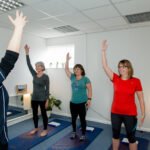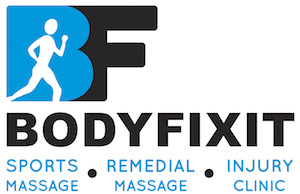In this blog we are going to go through what you need to know and expect for a beginners pilates class
Part 1 -Before picking a pilates class things for you to consider and know
-
What is pilates

pilates class as bodyfixit
Pilates was created by Joseph Pilates (first studio created in the 1920’s) and traditionally was 34 exercises which helped to strengthen muscles within your body, with a close link to training dancers. He believed that injury occurs due to imbalances within the body and incorrect movement patterns through pilates he tried to reduce this. Since then the exercises have been adapted to be suitable for everybody, allowing people to strengthen muscles and move better. I trained with Australian Physiotherapy and Pilates Institute (APPI) where the focus comes from a rehabilitation background. The aim of this form of pilates is to reduce aches and pains, help you become aware of how you are moving and progressing the exercises so that you are able to strengthen core and all over body muscles without making previous injuries worse.
-
What is the ‘core’
Core is talked about a lot now a days, but it can be misleading. For me essentially if you imagine your body and were to eliminate your arms and legs everything left behind is a core muscle. There are several layers to the core the main unit we call the supportive core is similar to a cylinder and is made up of the transverse abdominals (TVa) at the front, Diaphragm at the top, multifidus at the back and the pelvic floor at the bottom.
Next we have the strengthened core which consists of the latissimus dorsi, serratus anterior, obliques, quadratus lumborum, gluteals and thoracolumbar fascia,
So through pilates we aim to strengthen and improve the quality of movement of the functional core which is the supportive core, strengthened core and the extremities (arms and legs)
-
Classes or 121
Most people do pilates in a class format whether in a location or online in the current covid19 situation we find ourselves in. It is also possible to do pilates 121 where you get the instructors undivided attention and the exercises can be made specific to your needs.
-
Where can you do pilates classes?
There are quite a few different places you can do pilates from your local leisure centres, gyms, pilates focused centres, therapy clinics and some teachers rent local clubs, village halls and meeting areas.
-
Different types of pilates classes
The main differences are whether they are matwork or equipment based. Matwork pilates doesn’t typically involves equipment especially for beginners. It involves a pilates mat and a head cushion to help support you head in a comfortable and neutral position. As you progress small equipment like balls, weights or resistance bands maybe added. Equipment based pilates can vary from a reformer, pilates chair, ladders etc the aim of the equipment is to work against resistance further strengthen the muscles. Some centres offer classes specific to an injury ie back pain, pregnancy, men only, women only or even over 65’s.
-
Types of pilates teachers
Depending on where your instructor trained there teaching may have specific focus for example they might be traditional pilates trained the movements they teach are closely related to the original pilates exercises. More modern pilates techniques vary and be aware that the names of exercises might vary depending on the persons training, you might find this confusing if you try different instructors. If you have a specific issue like scolosis, pregnancy or back pain I recommend you check the teacher is experienced and knowledgeable in working with people with these issues.
Also something to be aware is different teaching styles. Depending on the type of teacher some teachers demonstrate the exercises they want you to do a couple of times and then walk around correctly people, some don’t demonstrate the exercise and others do the exercises as you are doing them. In my opinion it is really important that the instructor demos a couple of repetitions and then focuses on how you are doing the movements. The aim of pilates is to change incorrect movement patterns (how you move) and it is important that you are doing this the best that you can so that we are changing the incorrect movement pattern and strengthening the muscles you need to. I believe it is very difficult to do this if you are not looking at the people doing the class. So I recommend you find a teacher you connect with and that you feel gives you the support you need.
-
Size of pilates classes
This varies hugely between centres. I hear a lot from people who say they have tried pilates but it was a big class and they weren’t sure they were doing the exercises correctly or couldn’t keep up. I believe it is really important that classes are small as the teacher can then make sure you are doing the exercises correctly or give you modifications (variations on the exercises) if required. APPI recommend no more than 12 in a class at Bodyfixit our room is smaller so we have a maximum 8 in a class. This means we are aware how each client is doing the exercise, are able to help where needed and can dictate the speed of the exercises so no one feels like they are going to be left behind and not sure if doing it correctly.
-
Prices of classes
The price of pilates classes can vary and may depend on your location, the size of the classes, the experience of your teacher and whether equipment is involved or not. Some teachers do pay as you go and some offer memberships or programs. We find that if clients have program or membership they attend class more regularly so get better results meaning they feel better quicker and also they get to know other class members.
-
Doing classes online
This has been available for a while but during covid19 has become the go to way of doing pilates. There are 2 main ways you can do classes either through a recording like on youtube etc or on a live online class using something like zoom.
The main difference between these 2 is whether the teacher can see you doing your exercises or not. Personally I think a live class is better particularly as a beginner as the teacher is able to correct you if you are doing the movements not quite right or if you are unable to do a particular exercise due to a previous injury, you can be given a variation you can do or something different. You are also able to ask questions if you are not sure about something because there is an interaction between you and the teacher.
I think recorded classes are great if you know the basics and what is right for your body before you do a session without that interaction. I do recommend if you are doing an online session you check what qualifications, training or knowledge the teacher has and see if that is similar to your needs, so do a bit of research. Also check and see if they are able to give you a variation of levels so that you aren’t over doing it or making a previous injury worse.
Click here for part 2 – you have booked the class now what please click here
Click here for part 3 – before you walk in the pilates class what to know
We hope this encourages you to try a pilates class soon
Gemma
